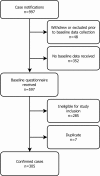Incidence of anorexia nervosa in young people in the UK and Ireland: a national surveillance study
- PMID: 31640991
- PMCID: PMC6954494
- DOI: 10.1136/bmjopen-2018-027339
Incidence of anorexia nervosa in young people in the UK and Ireland: a national surveillance study
Abstract
Objectives: This study aimed to estimate the incidence of DSM5 anorexia nervosa in young people in contact with child and adolescent mental health services in the UK and Ireland.
Design: Observational, surveillance study, using the Child and Adolescent Psychiatry Surveillance System, involving monthly reporting by child and adolescent psychiatrists between 1st February 2015 and 30th September 2015.
Setting: The study was based in the UK and Ireland.
Participants: Clinician-reported data on young people aged 8-17 in contact with child and adolescent mental health services for a first episode of anorexia nervosa.
Main outcome measures: Annual incidence rates (IRs) estimated as confirmed new cases per 100 000 population at risk.
Results: 305 incident cases of anorexia nervosa were reported over the 8-month surveillance period and assessed as eligible for inclusion. The majority were young women (91%), from England (70%) and of white ethnicity (92%). Mean age was 14.6 years (±1.66) and mean percentage of median expected body mass index for age and sex was 83.23% (±10.99%). The overall IR, adjusted for missing data, was estimated to be 13.68 per 100 000 population (95% CI 12.88 to 14.52), with rates of 25.66 (95% CI 24.09 to 27.30) for young women and 2.28 (95% CI 1.84 to 2.79) for young men. Incidence increased steadily with age, peaking at 15 (57.77, 95% CI 50.41 to 65.90) for young women and 16 (5.14, 95% CI 3.20 to 7.83) for young men. Comparison with earlier estimates suggests IRs for children aged 12 and under have increased over the last 10 years.
Conclusion: These results provide new estimates of the incidence of anorexia nervosa in young people. Service providers and commissioners should consider evidence to suggest an increase in incidence in younger children.
Trial registration number: ISRCTN12676087.
Keywords: anorexia nervosa; child & adolescent psychiatry; eating disorders; epidemiology.
© Author(s) (or their employer(s)) 2019. Re-use permitted under CC BY. Published by BMJ.
Conflict of interest statement
Competing interests: Tamsin Ford reports she is Chair of the Child and Adolescent Psychiatry Surveillance Service that was used to run part of the study, which is an unpaid position (other than travel expenses). Kandarp Joshi reports that he was principal investigator for the Aberdeen site for a Sunovion sponsored multisite trial on effectiveness of Lurasidone in paediatric schizophrenia.
Figures
References
Publication types
MeSH terms
Associated data
Grants and funding
LinkOut - more resources
Full Text Sources

